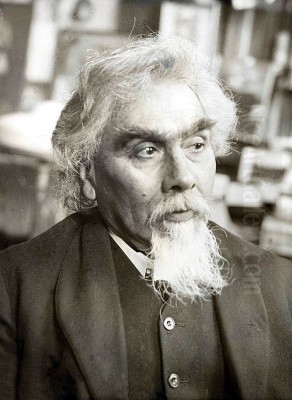
Jan Toorop (1858-1928) stands as a pivotal figure in the landscape of European art at the turn of the 20th century. A Dutch-Indonesian painter, his life and work traversed geographical and stylistic boundaries, leaving an indelible mark on Symbolism, Art Nouveau, and the broader development of modern art in the Netherlands and beyond. His unique background, born in the Dutch East Indies, infused his art with a distinct sensibility, blending European artistic currents with influences from his Javanese heritage.
Toorop's artistic journey was characterized by remarkable versatility and a constant drive for exploration. He moved fluidly between styles, absorbing and adapting Impressionism, Neo-Impressionism (specifically Pointillism), Symbolism, and Art Nouveau, often synthesizing these diverse approaches into a highly personal visual language. His contributions extended beyond painting to encompass illustration, poster design, stained glass, and portraiture, making him a truly multifaceted artist.
Early Life and Artistic Formation
Jean Theodoor Toorop, known as Jan, was born in Purworejo, on the island of Java, then part of the Dutch East Indies (now Indonesia). This Eastern origin would remain a subtle yet persistent influence throughout his career. His childhood interest in drawing and music hinted at the artistic path ahead. At the age of nine, his family relocated to the Netherlands, a move that profoundly shaped his future education and artistic development.
In the Netherlands, Toorop pursued formal art training. He studied at the Rijksakademie van beeldende kunsten (State Academy of Fine Arts) in Amsterdam and later at the Académie Royale des Beaux-Arts in Brussels. These institutions provided him with a solid academic foundation, but his artistic spirit soon sought more progressive avenues. His time in Brussels, a vibrant hub of avant-garde activity, proved particularly formative.
Early in his career, Toorop engaged with the prevailing styles of Realism and Impressionism, particularly the variant associated with the Amsterdam Impressionists. This initial phase showed his technical proficiency and his awareness of contemporary artistic trends, laying the groundwork for his later, more experimental phases.
Brussels and the Avant-Garde: Les XX
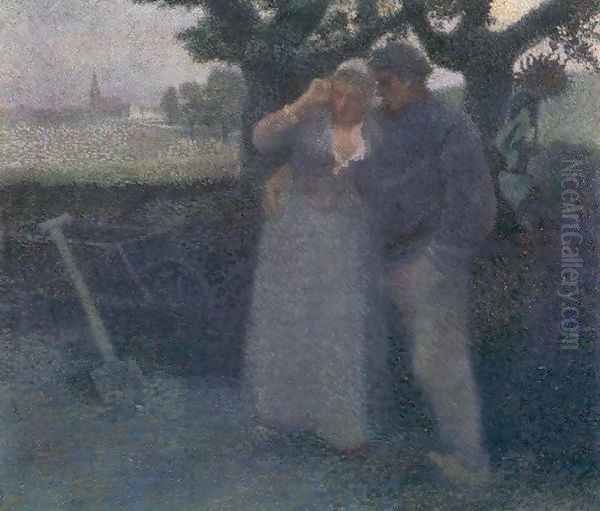
Toorop's connection with the Brussels art scene was crucial. Around 1882, he became involved with the progressive art group known as Les XX (Les Vingt, or The Twenty). This group, founded by Octave Maus, was a crucible for artistic innovation, exhibiting works by both Belgian and international artists who challenged academic conventions. Membership or close association with Les XX placed Toorop at the forefront of the European avant-garde.
Within this circle, Toorop interacted with influential figures like the Belgian painter James Ensor. The exchange of ideas and the exposure to diverse international styles, including French Impressionism and Neo-Impressionism, significantly broadened Toorop's artistic horizons. He also formed connections with artists like Théo van Rysselberghe and Henry van de Velde, who were also part of this radical milieu. Van de Velde, though based in Antwerp, maintained contact with Toorop through the group's annual exhibitions.
His involvement with Les XX facilitated his engagement with the latest artistic developments emanating from Paris and other centers. It was through these connections and the group's exhibitions that Toorop encountered and absorbed the principles of Neo-Impressionism, which would lead to his next significant stylistic phase.
Embracing Neo-Impressionism: The Pointillist Phase
Between approximately 1887 and 1890, Jan Toorop became a key proponent of Neo-Impressionism in the Netherlands. He is credited as being the first Dutch artist to adopt the Pointillist technique, pioneered by French artists Georges Seurat and Paul Signac. This method involved applying small, distinct dots of pure color to the canvas, relying on the viewer's eye to blend them optically, creating vibrant and luminous effects.
Toorop's Pointillist works often tackled social themes, reflecting an idealistic vision or a commentary on contemporary life. A notable example from this period is Bulb Fields, where the meticulous application of color dots captures the shimmering light and atmosphere of the Dutch landscape, while perhaps also hinting at the labor involved in its cultivation. His exploration of Pointillism demonstrated his willingness to experiment with scientific color theories and push the boundaries of representation.
This phase was relatively short-lived but highly significant. It showcased Toorop's role as a conduit, bringing cutting-edge French techniques to the Dutch art scene. His experiments with divided color and light laid groundwork that would influence other Dutch artists, including the young Piet Mondrian in his early explorations of light and color.
The Rise of Symbolism and the Javanese Influence
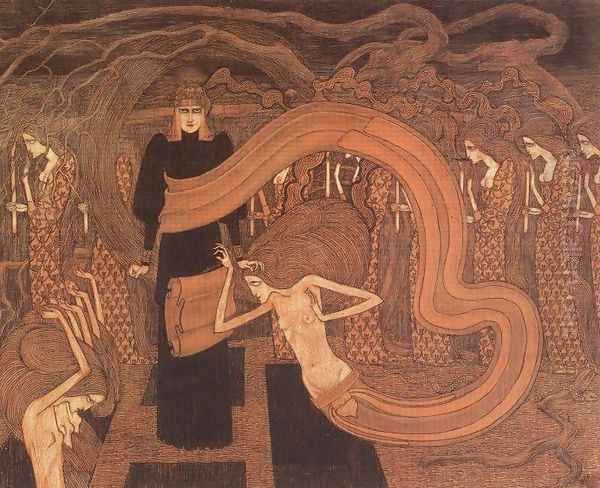
Following his Pointillist phase, Toorop moved decisively towards Symbolism in the early 1890s. This became the style for which he is perhaps most renowned. His Symbolist works are characterized by their sinuous, flowing lines, intricate patterns, and often mystical or spiritual atmosphere. He delved into profound themes, exploring concepts of religion, philosophy, life, death, and the human psyche.
A unique aspect of Toorop's Symbolism was the integration of elements drawn from his Javanese background. The stylized figures and linear rhythms in works like the iconic The Three Brides (1893) are often linked to the aesthetics of Javanese wayang (shadow puppet) theatre. This fusion resulted in a distinctive "Javanese style" or "Toorop style," marked by elongated, ethereal figures, complex decorative motifs, and a sense of otherworldly elegance.
His lines became highly expressive, often described as "whiplash" curves – dynamic, undulating lines that define forms and create intricate decorative patterns. This linear style became a hallmark of Art Nouveau, and Toorop's development of it was highly influential. Works such as Seduction (sometimes dated 1887, but stylistically fitting the early 1890s Symbolist period) exemplify this move towards linear abstraction and psychological depth. He explored the dualities of existence – spirit and matter, good and evil, the sacred and the profane – using a highly stylized visual language.
Art Nouveau and Diverse Media
Toorop's Symbolist style naturally evolved into and contributed significantly to the Art Nouveau movement. His emphasis on linear dynamism, decorative patterns, and the integration of art into everyday life aligned perfectly with the ideals of Art Nouveau. He became one of the leading figures of the Dutch variant of this international style, often referred to as Nieuwe Kunst.
His famous poster for Delft Salad Oil (Delftsche Slaolie), created around 1894-1895 (though sometimes cited as c. 1900), is a quintessential example of his Art Nouveau work and one of the most iconic posters of the era. The design features elegant female figures with flowing hair composed of intricate, rhythmic lines, demonstrating his mastery of the "whiplash" style in a commercial context. This work highlighted the Art Nouveau aim of breaking down barriers between fine art and applied art.
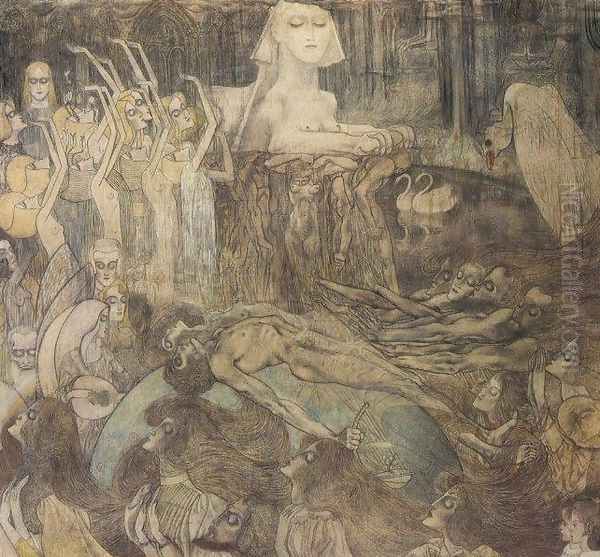
Toorop's creative output during this period was remarkably diverse. He continued to paint but also dedicated significant energy to graphic arts, including book illustrations, cover designs, and catalogues. Furthermore, he designed stained glass windows, bringing his linear style and symbolic content to architectural settings. His work across these various media consistently displayed his unique blend of European sophistication and echoes of his Indonesian heritage.
Faith and Later Works: A Spiritual Turn
A significant turning point in Toorop's life and art occurred in 1905 when he converted to Roman Catholicism. This conversion profoundly impacted his thematic focus, leading him to dedicate much of his later work to religious subjects. His artistic style adapted accordingly, moving towards a more restrained, sometimes more geometric, yet still highly linear form of religious Art Nouveau.
His religious works, including numerous depictions of saints, biblical scenes, and Stations of the Cross, often retained the elongated figures and flowing lines of his earlier Symbolist period but imbued them with a distinct spiritual intensity and devotional quality. He continued to work in various media, creating paintings, drawings, and designs for stained glass, often commissioned for churches.
Even in his later years, Toorop's style continued to evolve. Some later works show a move away from the strict linearity of his peak Art Nouveau phase towards forms that, while still stylized, incorporated a greater sense of volume and a bolder application of color, sometimes described as a transition towards a more naturalistic, albeit still highly personal, mode. Works like Time and Eternity (1901) and the perhaps problematically dated Belgium Bleeding (1901) might reflect earlier explorations of allegorical or potentially socio-political themes before his full immersion in Catholic iconography.
A Network of Influence: Connections and Collaborations
Jan Toorop was not an isolated figure; he was deeply embedded in the artistic networks of his time. His travels and participation in international exhibitions brought him into contact with numerous leading artists. Beyond his early association with James Ensor and Henry van de Velde in the context of Les XX, he interacted with James McNeill Whistler. His work resonated with that of Paul Cézanne, whose structural approach to form was gaining attention.
He played a crucial role in introducing Pointillism to the Netherlands, directly influenced by Georges Seurat and Paul Signac. His own Symbolist and Art Nouveau works, in turn, exerted considerable influence. Notably, his linear style is considered a significant inspiration for the Austrian master Gustav Klimt, who was instrumental in exhibiting Toorop's work in Vienna, indicating mutual respect and artistic dialogue.
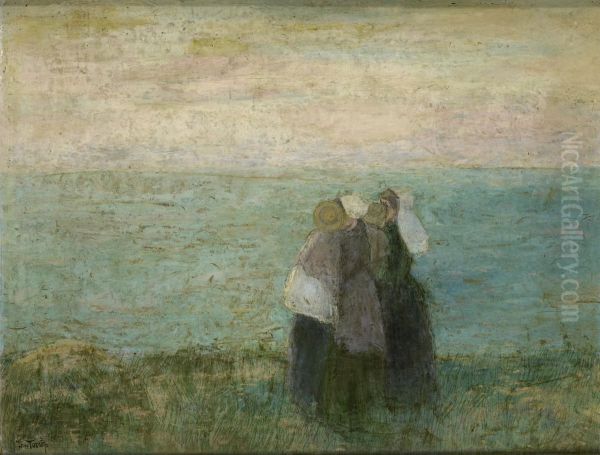
In the Netherlands, Toorop's impact was profound. He was a source of inspiration for younger artists, most significantly Piet Mondrian, whose early work shows clear debts to Toorop's Symbolist and Luminist (a Dutch variant of Neo-Impressionism) phases. Toorop was also an early champion of Vincent van Gogh in the Netherlands, helping to promote his work posthumously, which suggests an awareness and appreciation of Van Gogh's expressive power, even if their direct interaction was limited.
Toorop was also active in fostering artistic communities. He spent considerable time in the coastal village of Domburg in Zeeland, which became an important artists' colony under his influence, attracting Mondrian and others. He maintained connections with figures like the painter Marinus Wiersma and had personal friendships within the cultural sphere, such as Jeanette Marie de Langen, whose portrait he painted. His circle included poets, musicians, writers, and critics, reflecting his broad cultural engagement.
Personality and Anecdotes
Accounts suggest Jan Toorop possessed a vibrant and complex personality. He was described as passionate, humorous, and full of energy, characteristics that likely contributed to his wide circle of friends and his influential position in the art world. However, he was also known for being outspoken and perhaps eccentric, driven by an intense dedication to his artistic vision. This combination of traits could make him both highly respected and occasionally controversial among his peers.
His personal life included his marriage in 1886 to Annie Hall, an English woman. The couple lived in various locations, including England, Brussels, The Hague, and eventually settled for a time in the seaside town of Katwijk-aan-Zee. This period, particularly after his move to Katwijk, saw the creation of many significant works, increasingly reflecting the spiritual and symbolic concerns that would dominate his later career. His life involved navigating different cultures – his Javanese birth, Dutch upbringing, Belgian artistic connections, English marriage, and extensive European travel – all contributing to the rich tapestry of his experience and art.
Legacy and Collections
Jan Toorop died in The Hague in 1928, leaving behind a rich and complex artistic legacy. He is recognized as one of the most important Dutch artists of the late 19th and early 20th centuries, a key figure in the transition towards modernism. His primary contributions lie in his pioneering role within Dutch Symbolism and Art Nouveau, his early adoption of Pointillism, and his unique synthesis of European styles with Javanese aesthetics.

His influence extended to major figures like Gustav Klimt and Piet Mondrian, and his work in graphic design, particularly his posters, had a lasting impact on the field. He successfully navigated the worlds of fine art, applied art, and religious art, demonstrating remarkable versatility. His exploration of spiritual and psychological themes through a distinctive linear style continues to resonate.
Today, Jan Toorop's works are held in major museum collections, primarily in the Netherlands. Key institutions include the Rijksmuseum in Amsterdam, the Kröller-Müller Museum in Otterlo (which holds a significant collection of modern art), the Kunstmuseum Den Haag (formerly Gemeentemuseum, holding many works including the Delft Salad Oil poster design), and the Museum Boijmans Van Beuningen in Rotterdam. His enduring presence in these collections ensures that his unique artistic vision and his role as a bridge between cultures and styles remain accessible for study and appreciation.